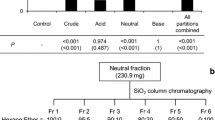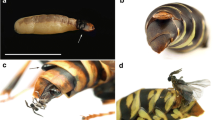Abstract
In a laboratory bioassay, adult female Frankliniella occidentalis (Pergande) (Thysanoptera: Thripidae) spent more time near filter paper disks that had been exposed to adult males than near unexposed disks; this effect was not observed on disks exposed to adult females. The response could only partly be explained by the known male-produced aggregation pheromone, neryl (S)-2-methylbutanoate, suggesting the presence of an unknown male-produced compound. In gas chromatography/mass spectrometry analyses, 7-methyltricosane was detected on disks exposed to males, but not on disks exposed to females. Extracts of cuticular lipids also showed relatively large amounts of 7-methyltricosane on males, whereas only trace amounts were found on females and none on larvae. Bioassays of synthetic 7-methyltricosane showed that adults responded only after contact. The response to this compound was clearly different from that to n-tricosane or hexane-only controls. Females that contacted 7-methyltricosane on glass beads stayed in the vicinity and frequently raised the abdomen, a behavior that rejects mating attempts by males. Males stayed in the vicinity and wagged the abdomen sideways, a behavior used in fighting between males. This is the first identification of a contact pheromone in the order Thysanoptera.




Similar content being viewed by others
References
Ablard, K., Gries, R., Khaskin, G., Schaefer, P. W., and Gries, G. 2012. Does the stereochemistry of methylated cuticular hydrocarbons contribute to mate recognition in the egg parasitoid wasp Ooencyrtus kuvanae? J. Chem. Ecol. 38:1306–1317.
Abramson, J. H. 2011. WINPEPI updated: Computer programs for epidemiologists, and their teaching potential. Epidemiol. Perspect. Innov. 8:1–9.
Bagnères, A.-G. and Blomquist, G. J. 2010. Site of synthesis, mechanism of transport and selective deposition of hydrocarbons, pp. 75–99, in G. J. Blomquist and A.-G. Bagnères (eds.), Insect Hydrocarbons. Cambridge University Press, Cambridge.
Blomquist, G. J. and Bagnères, A.-G. 2010. Insect Hydrocarbons. Cambridge University Press, Cambridge.
Dublon, I. A. N. 2009. The Aggregation Pheromone of the Western Flower Thrips. PhD dissertation, Keele University, UK.
El-Ghariani, I. M. and Kirk, W. D. J. 2008. The structure of the male sternal glands of the western flower thrips, Frankliniella occidentalis (Pergande). Acta Phytopathol. Entomol. Hung. 43:257–266.
Ellington, C. P. 1980. Wing mechanics and take off preparation of Thrips (Thysanoptera). J. Exp. Biol. 85:129–136.
Everaerts, C., Farine, J.-P., Cobb, M., and Ferveur, J.-F. 2010. Drosophila cuticular hydrocarbons revisited: Mating status alters cuticular profiles. PLoS One 5:e9607.
Gołębiowski, M., Maliński, E., Nawrot, J., Szafranek, J., and Stepnowski, P. 2007. Identification of the cuticular lipid composition of the western flower thrips Frankliniella occidentalis. Comp. Biochem. Physiol. B Biochem. Mol. Biol. 147:288–292.
Grenacher, S. and Guerin, P. M. 1994. Inadvertent introduction of squalene, cholesterol, and other skin products into a sample. J. Chem. Ecol. 20:3017–3025.
Hamilton, J. G. C., Hall, D. R., and Kirk, W. D. J. 2005. Identification of a male-produced aggregation pheromone in the western flower thrips Frankliniella occidentalis. J. Chem. Ecol. 31:1369–1379.
Hedrick, T. L. 2008. Software techniques for two- and three-dimensional kinematic measurements of biological and biomimetic systems. Bioinspir. Biomim. 3:034001.
Hemptinne, J. L., Lognay, G., and Dixon, A. F. G. 1998. Mate recognition in the two-spot ladybird beetle, Adalia bipunctata: Role of chemical and behavioural cues. J. Insect Physiol. 44:1163–1171.
Howard, R. W. and Blomquist, G. J. 2005. Ecological, behavioral, and biochemical aspects of insect hydrocarbons. Annu. Rev. Entomol. 50:371–393.
Jones, T. M. and Hamilton, J. G. C. 1998. A role for pheromones in mate choice in a lekking sandfly. Anim. Behav. 56:891–898.
Kirk, W. D. J. and Hamilton, J. G. C. 2010. The aggregation pheromones of thrips. (Abstract, IXth International Symposium on Thysanoptera and Tospoviruses, 31 August–4 September, 2009). J. Insect Sci. 10(166):19–20.
Kirk, W. D. J. and Terry, L. I. 2003. The spread of the western flower thrips Frankliniella occidentalis (Pergande). Agric. For. Entomol. 5:301–310.
Lacaille, F., Hiroi, M., Twele, R., Inoshita, T., Umemoto, D., Manière, G., Marion-Poll, F., Ozaki, M., Francke, W., Cobb, M., Everaerts, C., Tanimura, T., and Ferveur, J.-F. 2007. An inhibitory sex pheromone tastes bitter for Drosophila males. PLoS One 2:e661.
Lewis, T. 1997. Thrips as Crop Pests. CAB International, Wallingford.
Macdonald, K. M., Hamilton, J. G. C., Jacobson, R., and Kirk, W. D. J. 2003. Analysis of anal droplets of the western flower thrips Frankliniella occidentalis. J. Chem. Ecol. 29:2385–2389.
Mound, L. A. 2009. Sternal pore plates (glandular areas) of male Thripidae (Thysanoptera). Zootaxa 2129:29–46.
Rutledge, C. E., Millar, J. G., Romero, C. M., and Hanks, L. M. 2009. Identification of an important component of the contact sex pheromone of Callidiellum rufipenne (Coleoptera: Cerambycidae). Environ. Entomol. 38:1267–1275.
Takakura, K. I. 2009. Reconsiderations on evaluating methodology of repellent effects: Validation of indices and statistical analyses. J. Econ. Entomol. 102:1977–1984.
Terry, L. I. and Gardner, D. 1990. Male mating swarms in Frankliniella occidentalis (Pergande) (Thysanoptera: Thripidae). J. Insect Behav. 3:133–141.
Terry, I. and Schneider, M. 1993. Copulatory behaviour and mating frequency of the western flower thrips, Frankliniella occidentalis (Insecta: Thysanoptera). Zool. (J. Pure Appl. Zool.) 4:339–354.
Webster, K. W., Cooper, P., and Mound, L. A. 2006. Studies on Kelly’s citrus thrips, Pezothrips kellyanus (Bagnall) (Thysanoptera: Thripidae): Sex attractants, host associations and country of origin. Aust. J. Entomol. 45:67–74.
Widemo, F. and Johansson, B. G. 2006. Male-male pheromone signalling in a lekking Drosophila. Proc. R. Soc. Lond. B Biol. Sci. 273:713–717.
Wright, S. P. 1992. Adjusted P-values for simultaneous inference. Biometrics 48:1005–1013.
Xiao, Y.-H., Zhang, J.-X., and Li, S.-Q. 2010. Male-specific (Z)-9-tricosene stimulates female mating behaviour in the spider Pholcus beijingensis. Proc. R. Soc. Lond. B Biol. Sci. 277:3009–3018.
Zhang, P.-J., Zhu, X.-Y., and Lu, Y.-B. 2011. Behavioural and chemical evidence of a male-produced aggregation pheromone in the flower thrips Frankliniella intonsa. Physiol. Entomol. 36:317–320.
Zhao, C.-Y., He, Y.-R., Zhong, F., Gao, Y., Qi, G.-J., Shao, X.-Y., and Lv, L.-H. 2011. Analysis of cuticular hydrocarbons of Frankliniella occidentalis. Chin. J. Appl. Entomol. 48:536–541.
Acknowledgments
Oladele Olaniran thanks the Education Trust Fund, Nigeria and Ladoke Akintola University of Technology, Ogbomoso, Nigeria for providing a training fellowship. Akella Sudhakar acknowledges the support of the European Union under a Marie Curie International Incoming Fellowship (Project No: 252258, Project Acronym: PERFECT). David Hall was funded by Defra Horticultural LINK Project HL 01107. We thank Dudley Farman (NRI) for preparing filter disks and running the GC/MS analyses of exposed disks.
Author information
Authors and Affiliations
Corresponding author
Rights and permissions
About this article
Cite this article
Olaniran, O.A., Sudhakar, A.V.S., Drijfhout, F.P. et al. A Male-Predominant Cuticular Hydrocarbon, 7-Methyltricosane, is used as a Contact Pheromone in the Western Flower Thrips Frankliniella occidentalis . J Chem Ecol 39, 559–568 (2013). https://doi.org/10.1007/s10886-013-0272-5
Received:
Revised:
Accepted:
Published:
Issue Date:
DOI: https://doi.org/10.1007/s10886-013-0272-5




